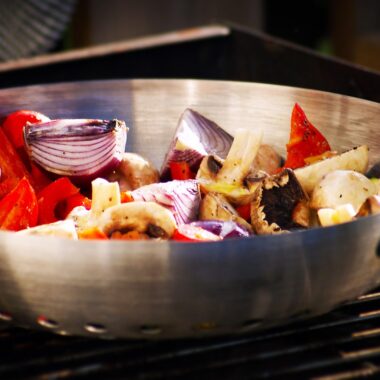Chop Suey, a dish with roots in Chinese-American cuisine, is a vibrant stir-fry that combines crisp vegetables, a savory sauce, and endless possibilities for customization. While it’s often associated with meat like chicken, pork, or beef, a vegetable-only version offers a lighter, healthier, and equally delicious alternative. Whether you’re a seasoned home cook or a beginner looking for a quick weeknight meal, Vegetable Chop Suey is a fantastic option that’s packed with flavor, nutrients, and versatility.
In this guide, we’ll dive into everything you need to know to make an irresistible Vegetable Chop Suey at home. From the essential ingredients to step-by-step cooking instructions, serving suggestions, and even some history behind the dish, this article has it all. Let’s get started with a recipe that’s sure to become a staple in your kitchen!
What is Chop Suey?
Before we jump into the recipe, let’s take a moment to understand what Chop Suey is. The name “Chop Suey” comes from the Cantonese term “tsap seui,” which roughly translates to “miscellaneous leftovers.” It’s believed to have originated in the United States in the late 19th century, created by Chinese immigrants adapting their cooking techniques to local ingredients and American tastes. While its exact origins are debated, Chop Suey has evolved into a beloved stir-fry dish featuring a medley of vegetables, a thickened sauce, and often a protein—though we’re keeping it veggie-focused here.
Vegetable Chop Suey skips the meat but doesn’t skimp on flavor. It’s a colorful mix of crunchy vegetables like bell peppers, carrots, and bean sprouts, all coated in a glossy, savory sauce that ties everything together. Served over rice or noodles, it’s a satisfying meal that’s as nutritious as it is delicious.
Ingredients for Vegetable Chop Suey
To make a fantastic Vegetable Chop Suey for 4 servings, you’ll need the following ingredients. Feel free to adjust quantities based on your preferences or what’s in your fridge—this dish is all about flexibility!
For the Stir-Fry:
- 2 tablespoons vegetable oil (or sesame oil for extra flavor)
- 1 medium onion, thinly sliced
- 2 garlic cloves, minced
- 1-inch piece of fresh ginger, peeled and finely chopped or grated
- 1 large carrot, julienned or thinly sliced
- 1 red bell pepper, sliced into strips
- 1 yellow bell pepper, sliced into strips
- 1 cup broccoli florets
- 1 cup snap peas or snow peas
- 1 cup bean sprouts
- 1 cup sliced mushrooms (shiitake, cremini, or button)
- 2-3 green onions, chopped (white and green parts separated)
- Optional: 1 cup shredded cabbage or bok choy for extra crunch
For the Sauce:
- 3 tablespoons soy sauce (low-sodium if preferred)
- 1 tablespoon oyster sauce (optional; use vegetarian oyster sauce if available)
- 1 tablespoon hoisin sauce
- 1 teaspoon cornstarch
- 1 teaspoon sugar (or honey)
- 1/2 cup vegetable broth or water
- 1 teaspoon rice vinegar or apple cider vinegar
- 1 teaspoon sesame oil
- Freshly ground black pepper to taste
To Serve:
- 4 cups cooked rice (white, brown, or jasmine) or 12 oz cooked noodles (chow mein, rice noodles, or lo mein)
Optional Garnishes:
- Toasted sesame seeds
- Chopped cilantro or parsley
- Crushed red pepper flakes for heat
Equipment You’ll Need
You don’t need fancy tools to make Vegetable Chop Suey, but having these on hand will make the process smoother:
- A large wok or deep skillet (non-stick works well)
- A sharp knife and cutting board
- A small bowl and whisk for the sauce
- A spatula or wooden spoon
- Measuring cups and spoons
Step-by-Step Instructions
Now, let’s get cooking! This recipe takes about 30 minutes from start to finish, including prep time. Follow these steps for a perfect Vegetable Chop Suey every time.
Step 1: Prepare the Ingredients
- Chop the Vegetables: Wash and slice all your vegetables as listed. Aim for uniform sizes so they cook evenly—thin strips or bite-sized pieces work best. Set them aside in separate piles or bowls for easy access during cooking.
- Make the Sauce: In a small bowl, whisk together the soy sauce, oyster sauce (if using), hoisin sauce, cornstarch, sugar, vegetable broth, rice vinegar, sesame oil, and black pepper until smooth. The cornstarch will help thicken the sauce later. Set this aside.
Step 2: Heat the Wok
- Place your wok or skillet over medium-high heat and add the vegetable oil. Let it heat until it shimmers slightly—this ensures your veggies will stir-fry, not steam.
- If using sesame oil, add it now for a nutty aroma, but be careful not to let it smoke.
Step 3: Stir-Fry the Aromatics
- Add the sliced onion to the hot oil and stir-fry for 1-2 minutes until it softens and becomes translucent.
- Toss in the minced garlic, ginger, and the white parts of the green onions. Stir-fry for another 30 seconds until fragrant. Be quick here—garlic burns easily!
Step 4: Cook the Vegetables
- Add the harder vegetables first: carrots, broccoli, and snap peas. Stir-fry for 2-3 minutes until they begin to soften but still retain some crunch.
- Next, add the bell peppers and mushrooms. Cook for another 2 minutes, stirring constantly to evenly distribute the heat.
- Finally, toss in the bean sprouts, cabbage (if using), and the green parts of the green onions. Stir-fry for 1 minute—just enough to warm them through without losing their texture.
Step 5: Add the Sauce
- Give the sauce mixture a quick stir (the cornstarch may have settled), then pour it into the wok.
- Toss everything together, coating the vegetables evenly. Cook for 1-2 minutes until the sauce thickens and turns glossy. If it’s too thick, add a splash of water or broth; if too thin, let it simmer a bit longer.
Step 6: Taste and Adjust
- Taste a spoonful of the stir-fry and adjust the seasoning if needed—more soy sauce for saltiness, a pinch of sugar for balance, or a dash of vinegar for tang.
- Once you’re happy with the flavor, turn off the heat.
Step 7: Serve
- Spoon the Vegetable Chop Suey over a bed of warm rice or noodles.
- Garnish with sesame seeds, cilantro, or red pepper flakes if desired. Serve immediately while it’s hot and the veggies are crisp!
Tips for the Best Vegetable Chop Suey
- Prep Ahead: Chop Suey cooks fast, so have all your ingredients ready before you start. This is called “mise en place,” and it’s a game-changer for stir-fries.
- High Heat is Key: A hot wok ensures the veggies stay crisp and don’t get soggy. If your stove isn’t powerful, work in batches to avoid overcrowding the pan.
- Customize the Veggies: Use whatever’s in season or in your fridge—zucchini, water chestnuts, or baby corn are great additions.
- Sauce Variations: Swap oyster sauce for mushroom sauce or add a splash of chili sauce for heat.
- Protein Boost: If you’re not strictly vegetarian, tofu, tempeh, or edamame can add extra substance.
Nutritional Benefits
Vegetable Chop Suey isn’t just tasty—it’s good for you, too! Here’s a quick breakdown of its health perks:
- Vitamins and Minerals: Bell peppers, broccoli, and carrots provide vitamins A, C, and K, plus antioxidants.
- Fiber: Bean sprouts, snap peas, and mushrooms keep your digestive system happy.
- Low-Calorie: Without heavy meats or oils, this dish is light yet filling.
- Customizable: Adjust sodium or sugar levels to suit your dietary needs.
A typical serving (with rice) clocks in at around 300-400 calories, depending on portion size and sauce tweaks.
Variations to Try
One of the best things about Chop Suey is its adaptability. Here are a few twists to keep things fresh:
- Spicy Chop Suey: Add sliced chilies, sriracha, or a teaspoon of chili garlic sauce to the mix.
- Crispy Noodle Version: Serve over fried chow mein noodles for a crunchy contrast.
- Sweet and Sour Twist: Mix in pineapple chunks and a tablespoon of ketchup for a tangy-sweet vibe.
- Thai-Inspired: Use fish sauce instead of soy sauce and garnish with peanuts and basil.
A Brief History of Chop Suey
Chop Suey’s story is as colorful as the dish itself. One popular tale claims it was invented in San Francisco during the Gold Rush, when a Chinese cook threw together leftovers for hungry miners and called it “chop suey.” Another theory ties it to Toisanese immigrants in the U.S., who adapted their stir-fry traditions to American palates. By the early 20th century, it was a staple in Chinese-American restaurants, often served with a side of rice or noodles.
While purists might argue it’s not “authentic” Chinese cuisine, Chop Suey reflects the ingenuity of immigrant cooking—a fusion of cultures that’s stood the test of time.
Conclusion
Vegetable Chop Suey is more than just a meal; it’s a celebration of simplicity, flavor, and creativity. With its quick prep, vibrant colors, and irresistible sauce, it’s a dish that invites you to experiment and make it your own. Whether you’re cooking for one or feeding a crowd, this recipe delivers satisfaction without the fuss.
So, grab your wok, raid your veggie drawer, and whip up a batch of Vegetable Chop Suey tonight. It’s a delicious way to eat your greens, enjoy a taste of history, and savor the joys of home cooking. Happy stirring!
References for Vegetable Chop Suey Recipe Article
Recipe and Cooking Techniques
- The Woks of Life
- Website: woksoflife.com
- Relevance: A trusted resource for Chinese and Chinese-American recipes, including stir-fry techniques and sauce formulations. Their Vegetable Chow Mein recipe shares similar principles with Chop Suey.
- Example: “Vegetable Chow Mein” (Updated March 2023).
- Serious Eats
- Website: seriouseats.com
- Relevance: Offers detailed guides on stir-fry cooking methods, wok usage, and vegetable preparation. J. Kenji López-Alt’s articles on stir-frying were influential for technique descriptions.
- Example: “The Food Lab: How to Stir-Fry Vegetables” (Published 2016).
- America’s Test Kitchen
- Book: The Complete Vegetarian Cookbook (2015)
- Relevance: Provides foundational recipes for vegetable stir-fries, including sauce ratios and cooking times adaptable to Chop Suey.
Nutritional Information
- USDA FoodData Central
- Website: fdc.nal.usda.gov
- Relevance: Used for general nutritional breakdowns of ingredients like bell peppers, broccoli, and bean sprouts to estimate vitamins, fiber, and calorie content.
- Harvard T.H. Chan School of Public Health – The Nutrition Source
- Website: hsph.harvard.edu/nutritionsource
- Relevance: Offers insights into the health benefits of vegetables featured in the recipe, such as antioxidants and fiber.
Historical Context
- Andrew Coe – Chop Suey: A Cultural History of Chinese Food in the United States
- Book: Published by Oxford University Press (2009)
- Relevance: A detailed exploration of Chop Suey’s origins and evolution in America, including the “leftover” theory and its ties to Chinese immigrant communities.
- Smithsonian Magazine
- Article: “The Mystery of Chop Suey” by Heather Richter (October 2015)
- Relevance: Discusses competing origin stories and the dish’s rise in popularity in the U.S., supporting the historical section.
- PBS – American Experience
- Documentary: “The Chinese Exclusion Act” (2018)
- Relevance: Provides context on Chinese immigration in the late 19th century, linking to the cultural fusion that birthed Chop Suey.
General Culinary Inspiration
- Bon Appétit
- Website: bonappetit.com
- Relevance: Offers modern takes on stir-fries and sauce variations that influenced the optional twists section.
- Cook’s Illustrated
- Website: cooksillustrated.com
- Relevance: Known for precise cooking methods and ingredient substitutions, informing tips like prepping ahead and sauce adjustments.


















